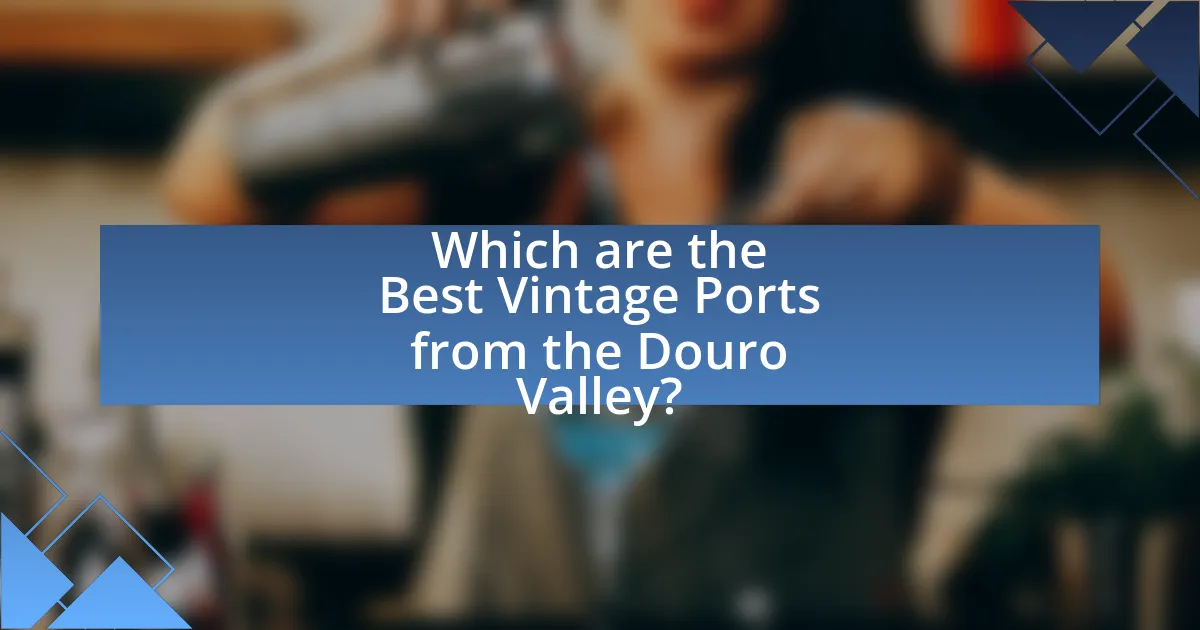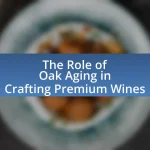Vintage Ports from the Douro Valley are premium fortified wines made from grapes harvested in a single exceptional year, known for their rich flavors, complexity, and significant aging potential. This article explores the unique characteristics of Vintage Ports, differentiating them from other Port styles, and highlights the importance of the Douro Valley’s terroir and climate in producing these wines. It also examines the historical context of Vintage Port production, notable producers, and the criteria for evaluating quality, alongside recommendations for enjoying and pairing these wines effectively. Key vintage years and expert ratings are discussed to guide consumers in selecting exceptional Vintage Ports.

What are Vintage Ports from the Douro Valley?
Vintage Ports from the Douro Valley are high-quality fortified wines produced from grapes harvested in a single exceptional year. These wines are characterized by their rich flavors, complexity, and aging potential, often requiring decades to reach their peak. The Douro Valley, a UNESCO World Heritage site, is renowned for its unique terroir, which includes steep vineyards and a hot, dry climate, contributing to the distinctive characteristics of Vintage Ports. The production process involves traditional methods, including foot treading of grapes and aging in oak barrels, which enhances the wine’s depth and structure.
How is Vintage Port different from other types of Port wine?
Vintage Port is distinct from other types of Port wine primarily due to its production process and aging potential. Unlike Ruby or Tawny Ports, which are blended from various vintages and often aged in barrels for extended periods, Vintage Port is made from grapes harvested in a single exceptional year and is bottled after a short aging period in cask, typically around two years. This specific method allows Vintage Port to retain more of the fruit’s original character and complexity, resulting in a wine that can age for decades, developing intricate flavors over time. The classification of Vintage Port is also regulated by the Instituto dos Vinhos do Douro e Porto, which requires that the wine meets strict quality standards, further differentiating it from other Port styles that may not adhere to such rigorous criteria.
What are the key characteristics of Vintage Port?
Vintage Port is characterized by its rich, concentrated flavors, high tannin content, and significant aging potential. This fortified wine is made from the best grapes of a single harvest, typically from the Douro Valley, and is bottled unfiltered, allowing it to develop complex flavors over time. Vintage Ports often exhibit notes of dark fruits, chocolate, and spices, and they require a minimum of two years of aging in the bottle before release, with many improving for decades. The quality of Vintage Port is determined by the declaration of the vintage year, which is made by producers only in exceptional years, ensuring that only the finest wines are labeled as Vintage Port.
Why is the Douro Valley significant for Vintage Port production?
The Douro Valley is significant for Vintage Port production due to its unique terroir, which includes steep, terraced vineyards and a climate that is ideal for growing the specific grape varieties used in Port wine. The region’s schist soil retains heat, promoting optimal ripening of grapes such as Touriga Nacional and Tinta Roriz, which are essential for high-quality Vintage Ports. Additionally, the Douro River’s influence moderates temperatures, contributing to the development of complex flavors in the grapes. This combination of geographical and climatic factors has established the Douro Valley as a premier location for producing some of the world’s finest Vintage Ports, recognized for their richness and aging potential.
What factors contribute to the quality of Vintage Ports?
The quality of Vintage Ports is primarily influenced by grape variety, terroir, winemaking techniques, and aging potential. The grape varieties, such as Touriga Nacional and Tinta Roriz, contribute distinct flavors and aromas essential for high-quality Port. Terroir, which encompasses soil composition, climate, and vineyard location in the Douro Valley, significantly affects the grapes’ ripeness and concentration of flavors. Winemaking techniques, including fermentation methods and blending practices, also play a crucial role in determining the final product’s complexity and balance. Finally, the aging potential of Vintage Ports, which can improve over decades, is a key factor in their overall quality, as it allows for the development of nuanced flavors and aromas over time.
How do terroir and climate influence Vintage Port quality?
Terroir and climate significantly influence Vintage Port quality by affecting grape characteristics and ripening conditions. The Douro Valley’s unique terroir, which includes soil composition, altitude, and slope orientation, contributes to the distinct flavor profiles and complexity of the grapes. For instance, schist soils retain heat and moisture, promoting optimal grape maturation. Additionally, the region’s climate, characterized by hot summers and cold winters, allows for a balanced ripening process, essential for developing the sugars and acidity needed for high-quality Port. Historical data shows that exceptional vintages often correlate with specific climatic conditions, such as a dry growing season followed by timely rainfall, which enhances grape quality and concentration.
What grape varieties are essential for producing high-quality Vintage Ports?
The essential grape varieties for producing high-quality Vintage Ports are Touriga Nacional, Touriga Franca, Tinta Roriz, Tinta Barroca, and Tinto Cão. Touriga Nacional is renowned for its aromatic complexity and structure, making it a cornerstone of Vintage Port blends. Touriga Franca contributes elegance and floral notes, while Tinta Roriz adds body and richness. Tinta Barroca enhances the blend with fruitiness, and Tinto Cão provides acidity and longevity. These varieties are cultivated in the Douro Valley, where the unique terroir and climate conditions support their growth, ensuring the production of exceptional Vintage Ports.
What is the history of Vintage Port production in the Douro Valley?
Vintage Port production in the Douro Valley has a rich history dating back to the 17th century when British merchants began to export wine from the region. The establishment of the Port wine trade was significantly influenced by the Methuen Treaty of 1703, which facilitated trade between England and Portugal. By the 19th century, the Douro Valley was recognized for its unique terroir, leading to the classification of vineyards and the establishment of the first demarcated wine region in the world in 1756. The introduction of the “Port” designation was formalized, and the production methods, including the use of specific grape varieties like Touriga Nacional and Tinta Roriz, were refined. The 20th century saw the rise of Vintage Port as a prestigious category, with notable vintages being declared in years such as 1945, 1963, and 1994, solidifying the Douro Valley’s reputation as a premier wine-producing region.
How has the production process evolved over time?
The production process of vintage ports from the Douro Valley has evolved significantly from traditional methods to modern techniques. Initially, the production relied heavily on manual labor, with grapes being foot-trodden in lagares, or stone troughs, to extract juice. Over time, mechanization introduced grape harvesting machines and automated pressing systems, enhancing efficiency and consistency. Additionally, advancements in fermentation technology, such as temperature control and the use of stainless steel tanks, have improved the quality and stability of the wine. Historical records indicate that the introduction of fortified wine production in the 17th century marked a pivotal change, allowing for longer aging and better preservation, which has continued to influence contemporary practices in the region.
What historical events have shaped the Douro Valley’s wine industry?
The Douro Valley’s wine industry has been significantly shaped by several historical events, including the establishment of the Port wine trade in the 17th century, the introduction of the Wine Regulation Act in 1756, and the phylloxera crisis in the late 19th century. The Port wine trade began when British merchants sought to import wine from Portugal, leading to the creation of fortified wines that became popular in England. The Wine Regulation Act of 1756 marked the first demarcation of the Douro Valley as a protected wine region, establishing regulations that ensured quality and authenticity. The phylloxera crisis devastated vineyards across Europe, including the Douro Valley, prompting the replanting of vineyards with American rootstocks, which ultimately transformed the region’s wine production methods and varietals. These events collectively laid the foundation for the Douro Valley’s reputation as a premier wine-producing region.

Which are the Best Vintage Ports from the Douro Valley?
The best vintage ports from the Douro Valley include the 2011 Quinta do Noval Nacional, the 2016 Taylor’s Vintage Port, and the 2017 Graham’s Vintage Port. The 2011 Quinta do Noval Nacional is renowned for its exceptional quality and complexity, often regarded as one of the finest ports ever produced. Taylor’s 2016 Vintage Port is celebrated for its rich fruit flavors and aging potential, while Graham’s 2017 Vintage Port is noted for its balance and elegance. These ports have received high ratings from wine critics and are sought after by collectors, confirming their status as top selections from the region.
What criteria should be used to evaluate the best Vintage Ports?
The criteria to evaluate the best Vintage Ports include the quality of the grapes, the winemaking process, aging potential, and overall balance of flavors. High-quality grapes, typically from specific regions in the Douro Valley, are essential as they influence the wine’s complexity and richness. The winemaking process, including fermentation and blending techniques, significantly impacts the final product’s character. Aging potential is crucial, as the best Vintage Ports can develop and improve over decades, showcasing their longevity. Finally, the overall balance of flavors—such as fruitiness, acidity, tannins, and sweetness—determines the wine’s harmony and drinkability. These criteria are supported by the fact that renowned producers like Taylor’s and Graham’s consistently achieve high ratings from wine critics, reflecting their adherence to these standards.
How do expert ratings and reviews influence the perception of Vintage Ports?
Expert ratings and reviews significantly shape the perception of Vintage Ports by providing authoritative assessments that guide consumer choices. These evaluations often highlight the quality, flavor profiles, and aging potential of specific Vintage Ports, influencing both collectors and casual drinkers. For instance, high scores from reputable wine critics, such as Robert Parker or Wine Spectator, can lead to increased demand and higher prices for those vintages, as consumers often rely on expert opinions to navigate the complexities of wine selection. Additionally, expert reviews can enhance the prestige of certain producers, thereby affecting brand reputation and consumer trust in the Vintage Port market.
What role does vintage year play in determining quality?
The vintage year plays a crucial role in determining the quality of vintage ports, as it reflects the climatic conditions and grape harvest of that specific year. For instance, years with optimal weather conditions, such as balanced rainfall and favorable temperatures, typically yield grapes with higher sugar levels and better acidity, resulting in superior wine quality. Historical data shows that exceptional vintages, like 2011 and 2016 in the Douro Valley, are often celebrated for their complexity and aging potential, while less favorable years may produce wines that lack depth and character. Thus, the vintage year serves as a key indicator of the wine’s potential quality and longevity.
What are some notable producers of Vintage Port in the Douro Valley?
Notable producers of Vintage Port in the Douro Valley include Quinta do Noval, Graham’s, and Taylor’s. Quinta do Noval is renowned for its exceptional quality and has a history dating back to the 18th century, producing some of the most sought-after Vintage Ports. Graham’s, established in 1820, is known for its rich and complex wines, often receiving high ratings from wine critics. Taylor’s, founded in 1692, is one of the oldest Port houses and is celebrated for its consistent excellence in Vintage Port production, with numerous awards and accolades over the years.
Which wineries are renowned for their exceptional Vintage Ports?
The wineries renowned for their exceptional Vintage Ports include Quinta do Noval, Graham’s, Taylor’s, and Fonseca. These wineries have consistently produced high-quality Vintage Ports, with Quinta do Noval being recognized for its unique terroir and innovative winemaking techniques. Graham’s is celebrated for its rich, full-bodied styles, while Taylor’s is known for its age-worthy and complex offerings. Fonseca has a reputation for its opulent and fruity Vintage Ports. Each of these wineries has a long history of excellence, contributing to their esteemed status in the world of Vintage Port production.
What unique practices do these producers employ?
Producers of vintage ports in the Douro Valley employ unique practices such as traditional foot treading of grapes, which enhances the extraction of flavors and tannins. This method, known as “lagar,” allows for gentle crushing and fermentation, resulting in a richer wine profile. Additionally, many producers utilize specific vineyard terracing techniques that optimize sun exposure and drainage, contributing to the distinct terroir of the region. These practices are rooted in centuries-old traditions, ensuring the preservation of quality and authenticity in the production of vintage ports.
How can one identify exceptional Vintage Ports when purchasing?
To identify exceptional Vintage Ports when purchasing, one should look for specific indicators such as the producer’s reputation, vintage quality ratings, and the wine’s provenance. Renowned producers like Taylor’s, Graham’s, and Fonseca consistently deliver high-quality Vintage Ports, as evidenced by their historical performance in wine competitions and expert reviews. Additionally, checking vintage charts from reputable sources like Wine Spectator or Decanter can provide insights into the quality of specific years, with top vintages often rated 95 points or higher. Lastly, ensuring the wine has been stored properly and comes from a reliable source can further confirm its quality, as improper storage can significantly affect the wine’s integrity.
What labels or indicators should consumers look for?
Consumers should look for labels indicating “Vintage Port,” “Declared Vintage,” and “Douro Valley” when selecting vintage ports. These labels signify that the wine has met specific quality standards and has been produced from grapes harvested in a single year, which is essential for authentic vintage port. Additionally, the “Aged Tawny” label can indicate a different style of port that has been aged in wood, offering a distinct flavor profile. The presence of these labels ensures that consumers are purchasing high-quality products that reflect the traditional practices of the Douro Valley region.
How does provenance affect the value of Vintage Ports?
Provenance significantly affects the value of Vintage Ports by establishing authenticity and quality. A well-documented provenance, including the vineyard’s history, production methods, and storage conditions, assures collectors and investors of the wine’s legitimacy and potential for aging. For instance, Vintage Ports from renowned producers like Quinta do Noval or Graham’s, with a strong historical reputation, command higher prices due to their established track record of excellence. Additionally, wines with a clear provenance are less likely to be counterfeit, which is a critical concern in the high-value wine market. Thus, provenance not only enhances the perceived quality but also directly correlates with market demand and pricing.

How to Enjoy and Pair Vintage Ports from the Douro Valley?
To enjoy and pair Vintage Ports from the Douro Valley, serve them at a slightly cooler temperature of around 60-65°F (15-18°C) to enhance their complex flavors. Pair these rich, full-bodied wines with strong cheeses like blue cheese or aged cheddar, as well as dark chocolate desserts, which complement the wine’s sweetness and depth. The high tannin content and fruity notes of Vintage Ports also pair well with roasted meats, particularly lamb or beef, creating a balanced dining experience. These pairing suggestions are supported by the traditional practices of wine connoisseurs who have long recognized the compatibility of these flavors.
What are the best serving practices for Vintage Ports?
The best serving practices for Vintage Ports include decanting the wine before serving and serving it at a temperature between 60°F to 65°F (15°C to 18°C). Decanting helps separate the wine from any sediment that may have formed during aging, enhancing the clarity and flavor profile. Serving at the recommended temperature allows the complex aromas and flavors to be fully appreciated. Additionally, Vintage Ports are best enjoyed in smaller glasses to concentrate the aromas, and they pair well with rich foods like blue cheese or dark chocolate, which complement their sweetness and depth.
How should Vintage Ports be stored for optimal enjoyment?
Vintage Ports should be stored upright in a cool, dark place with a stable temperature between 55°F and 65°F (13°C to 18°C) and humidity levels around 70%. This storage method prevents cork deterioration and minimizes exposure to light, which can degrade the wine. Additionally, avoiding vibrations and storing bottles away from strong odors will help maintain the wine’s quality over time. Proper storage conditions are essential for preserving the complex flavors and aromas that characterize Vintage Ports, ensuring optimal enjoyment when opened.
What glassware is recommended for tasting Vintage Ports?
The recommended glassware for tasting Vintage Ports is a large, tulip-shaped glass. This design allows for the concentration of aromas, enhancing the sensory experience of the wine. The wider bowl provides ample surface area for aeration, while the narrower opening helps to focus the complex bouquet of scents typical of Vintage Ports. This glass shape is widely endorsed by wine experts and sommeliers for its ability to elevate the tasting experience.
What foods pair well with Vintage Ports?
Vintage Ports pair well with rich foods such as blue cheeses, dark chocolate, and roasted meats. The sweetness and complexity of Vintage Ports complement the strong flavors of blue cheeses like Roquefort or Stilton, enhancing the tasting experience. Dark chocolate, particularly varieties with high cocoa content, balances the wine’s sweetness and acidity, creating a harmonious pairing. Additionally, roasted meats, especially lamb or beef, provide a savory contrast that highlights the wine’s depth and richness. These pairings are widely recognized among wine enthusiasts and are supported by culinary traditions that emphasize the balance of flavors.
How do different flavor profiles of Vintage Ports influence food pairings?
Different flavor profiles of Vintage Ports significantly influence food pairings by enhancing or contrasting the flavors of the dishes served. For instance, Vintage Ports with rich, fruity notes, such as blackberry and plum, pair well with chocolate desserts and blue cheeses, as the sweetness of the wine complements the richness of these foods. Conversely, Vintage Ports that exhibit spicier or more tannic characteristics, often found in younger vintages, can enhance savory dishes like grilled meats or game, where the wine’s structure balances the protein’s richness. This pairing strategy is supported by the traditional practice of serving Vintage Ports with specific foods, which has been documented in wine and culinary literature, emphasizing the importance of matching the wine’s flavor profile to the dish’s characteristics for an optimal tasting experience.
What are some classic pairings that enhance the tasting experience?
Classic pairings that enhance the tasting experience of Vintage Ports from the Douro Valley include blue cheese, dark chocolate, and dried fruits. Blue cheese, such as Roquefort, complements the sweetness and richness of the port, creating a balanced flavor profile. Dark chocolate, particularly varieties with high cocoa content, enhances the fruity notes of the port, while dried fruits like figs and apricots provide a contrasting texture and sweetness that elevates the overall tasting experience. These pairings are well-established in culinary traditions, supported by the historical appreciation of port wine’s complex flavors and its ability to harmonize with rich, bold foods.
What tips can enhance the enjoyment of Vintage Ports?
To enhance the enjoyment of Vintage Ports, serve them at the optimal temperature of 60-65°F (15-18°C) to fully appreciate their complex flavors. This temperature allows the rich fruit notes and subtle tannins to express themselves effectively. Additionally, decanting Vintage Ports for at least an hour before serving aerates the wine, softening its tannins and releasing aromatic compounds, which improves the overall tasting experience. Pairing Vintage Ports with complementary foods, such as blue cheese or dark chocolate, can also elevate enjoyment by balancing the wine’s sweetness with savory or bitter flavors.
How can one host a successful Vintage Port tasting event?
To host a successful Vintage Port tasting event, one should carefully select a range of high-quality Vintage Ports from reputable producers, ensuring a diverse representation of styles and vintages. This selection process is crucial because the Douro Valley is known for its exceptional Port wines, with notable producers like Taylor’s, Graham’s, and Fonseca offering distinct flavor profiles that enhance the tasting experience.
Additionally, the event should be organized in a suitable venue that allows for comfortable seating and proper wine service, as the environment significantly impacts guest enjoyment. Providing appropriate glassware, such as tulip-shaped glasses, is essential for appreciating the aromas and flavors of the Ports.
Furthermore, offering food pairings that complement the wines, such as cheeses, chocolates, and dried fruits, can elevate the tasting experience. Educational elements, such as a brief introduction to the history of Vintage Port and the Douro Valley, can also engage guests and enhance their appreciation of the wines being tasted.
Finally, ensuring that the event is well-promoted and that guests are informed about the wines they will be tasting can lead to a more enjoyable and memorable experience.
What common mistakes should be avoided when tasting Vintage Ports?
Common mistakes to avoid when tasting Vintage Ports include not decanting the wine, serving it at the wrong temperature, and neglecting to assess the wine’s appearance and aroma before tasting. Decanting is crucial as it allows the wine to aerate, enhancing its flavors and aromas; failing to do so can result in a less enjoyable experience. Serving Vintage Ports too cold or too warm can mask their complex flavors; the ideal serving temperature is between 60-65°F (15-18°C). Additionally, overlooking the visual and olfactory aspects can lead to missing out on the wine’s full character, as the appearance and aroma provide essential context for the tasting experience.


